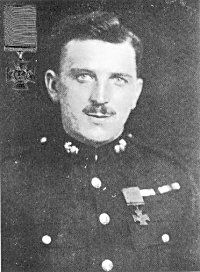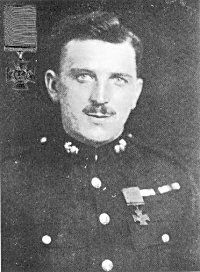London Gazette Citation 23rd July 1918.
"Serjeant Finch was second-in-command of the ‘pom-poms' and Lewis machine guns in the foretop of HMS Vindictive, under Lieutenant Charles N. B. Rigby, R.M.A. At one period Vindictive was being hit every few seconds, chiefly on the upper works, from which splinters caused many casualties. It was difficult to locate the guns which were doing the most damage, but Lieutenant Rigby, Serjeant Finch and the Marines in the foretop, kept up a continuous fire with pompoms and Lewis , changing rapidly from one target to another, and thus keeping the enemy's fire down to some considerable extent.Unfortunately two heavy shells made direct hits on the foretop, which was completely exposed to enemy concentration of fire. All in the top were killed or disabled, except Sergeant Finch, who was, however, severely wounded; nevertheless he showed consummate bravery, remaining in his battered and exposed position. He once more got a Lewis gun into action, and kept up a continuous fire, harassing the enemy on the mole, until the foretop received another direct hit, the remainder of the armament being then completely put out of action. Before the top was destroyed Serjeant Finch had done invaluable work, and by his bravery undoubtedly saved many lives. This very gallant Serjeant of the Royal Marine Artillery was selected by the 4th Battalion of Royal Marines, who were mostly Royal Marine Light Infantry, to receive the Victoria Cross under Rule 13 of the Royal Warrant, dated 29th January 1856." A further 6 participants in the action also received the Victoria Cross by ballot and one other was awarded in the usual manner. After the Great War he became an Instructor of Coast Defence Gunnery and was made Colour Sergeant on 12th August 1920, and after varied service at home and abroad he left the service from Eastney with the rank of Barrack Quartermaster,[appointed December 23rd 1925] with a recommendation for the Meritorious Service Medal. He retired from service with the rank of Quartermaster Sergeant in December 1929. On 1st January 1931 he was appointed a Yeoman of the Guard. As the threat of another World War loomed, he re-enlisted in the Portsmouth Division in 1938 and served in World War II, mostly as Quartermaster but with promotion to the rank of Temporary Lieutenant (QM) on 25th February 1941. He served as a Storekeeper Officer at 104 (Training) RM Brigade, R.M. Training Group Dalditch, Budleigh Salterton in Devon. He was 'de-mobbed' on 15 August 1945 and in 1964 he was appointed Divisional Sergeant-Major in Her Majesty's Bodyguard of the Yeomen of the Guard and awarded the Royal Victorian Medal for his services. His other decorations were the 1914/15 Star, the British War and Victory Medals, [the ‘Pip, Squeak and Wilfred' trio- Pip, Squeak and Wilfred was a long-running British newspaper strip cartoon published in the Daily Mirror from 1919 to 1956,After the First World War 1914-18, three medals were awarded to most of the British servicemen that had served from 1914 or 1915. They were the British War Medal, the British Victory Medal and either the 1914 Star or the 1914-15 Star. They were irreverently referred to as Pip, Squeak, and Wilfred and are still so today.] and on 27th January 1924, the Long Service and Good Conduct Medal. He had married Elizabeth Jane Ross in Birmingham on 3rd April 1919. He died aged 75 in St. Mary's Hospital, Portsmouth on 15th March 1966 and was cremated at Porchester. A memorial plaque to him was unveiled in St Andrew's Church, Henderson Road, Eastney on 23rd April 1967. The church has since been converted into housing and the memorial was removed to the Chapel in Stonehouse Barracks in Plymouth. Portsmouth City Council named a new road in Eastney after him. His Victoria Cross [red ribbon] was bequeathed to the Corps and is displayed at the Royal Marines Museum in Eastney, Southsea.
London Gazette Citation 23rd July 1918.
"Serjeant Finch was second-in-command of the ‘pom-poms' and Lewis machine guns in the foretop of HMS Vindictive, under Lieutenant Charles N. B. Rigby, R.M.A. At one period Vindictive was being hit every few seconds, chiefly on the upper works, from which splinters caused many casualties. It was difficult to locate the guns which were doing the most damage, but Lieutenant Rigby, Serjeant Finch and the Marines in the foretop, kept up a continuous fire with pompoms and Lewis , changing rapidly from one target to another, and thus keeping the enemy's fire down to some considerable extent.Unfortunately two heavy shells made direct hits on the foretop, which was completely exposed to enemy concentration of fire. All in the top were killed or disabled, except Sergeant Finch, who was, however, severely wounded; nevertheless he showed consummate bravery, remaining in his battered and exposed position. He once more got a Lewis gun into action, and kept up a continuous fire, harassing the enemy on the mole, until the foretop received another direct hit, the remainder of the armament being then completely put out of action. Before the top was destroyed Serjeant Finch had done invaluable work, and by his bravery undoubtedly saved many lives. This very gallant Serjeant of the Royal Marine Artillery was selected by the 4th Battalion of Royal Marines, who were mostly Royal Marine Light Infantry, to receive the Victoria Cross under Rule 13 of the Royal Warrant, dated 29th January 1856." A further 6 participants in the action also received the Victoria Cross by ballot and one other was awarded in the usual manner. After the Great War he became an Instructor of Coast Defence Gunnery and was made Colour Sergeant on 12th August 1920, and after varied service at home and abroad he left the service from Eastney with the rank of Barrack Quartermaster,[appointed December 23rd 1925] with a recommendation for the Meritorious Service Medal. He retired from service with the rank of Quartermaster Sergeant in December 1929. On 1st January 1931 he was appointed a Yeoman of the Guard. As the threat of another World War loomed, he re-enlisted in the Portsmouth Division in 1938 and served in World War II, mostly as Quartermaster but with promotion to the rank of Temporary Lieutenant (QM) on 25th February 1941. He served as a Storekeeper Officer at 104 (Training) RM Brigade, R.M. Training Group Dalditch, Budleigh Salterton in Devon. He was 'de-mobbed' on 15 August 1945 and in 1964 he was appointed Divisional Sergeant-Major in Her Majesty's Bodyguard of the Yeomen of the Guard and awarded the Royal Victorian Medal for his services. His other decorations were the 1914/15 Star, the British War and Victory Medals, [the ‘Pip, Squeak and Wilfred' trio- Pip, Squeak and Wilfred was a long-running British newspaper strip cartoon published in the Daily Mirror from 1919 to 1956,After the First World War 1914-18, three medals were awarded to most of the British servicemen that had served from 1914 or 1915. They were the British War Medal, the British Victory Medal and either the 1914 Star or the 1914-15 Star. They were irreverently referred to as Pip, Squeak, and Wilfred and are still so today.] and on 27th January 1924, the Long Service and Good Conduct Medal. He had married Elizabeth Jane Ross in Birmingham on 3rd April 1919. He died aged 75 in St. Mary's Hospital, Portsmouth on 15th March 1966 and was cremated at Porchester. A memorial plaque to him was unveiled in St Andrew's Church, Henderson Road, Eastney on 23rd April 1967. The church has since been converted into housing and the memorial was removed to the Chapel in Stonehouse Barracks in Plymouth. Portsmouth City Council named a new road in Eastney after him. His Victoria Cross [red ribbon] was bequeathed to the Corps and is displayed at the Royal Marines Museum in Eastney, Southsea.
Gravesite Details
His ashes were interred at South Stoneham Cemetery.
Sponsored by Ancestry
Advertisement
Advertisement


